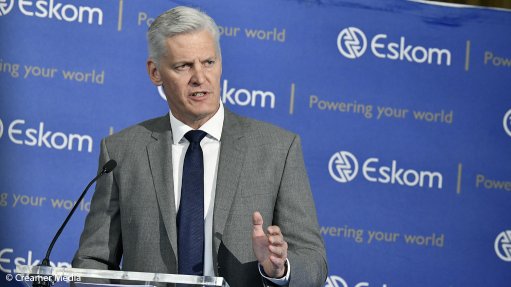
Eskom CEO André de Ruyter
Photo by: Creamer Media's Donna Slater
Eskom has confirmed that it intends procuring engineering and maintenance services from original-equipment manufacturers (OEMs) in the coming months to supplement its skills base at power stations that have become prone to repeated unplanned breakdowns.
CEO André de Ruyter said the strategy was still being canvassed with organised labour and with government, but that he expected the first OEM “boots on the ground” within the coming three to six months.
Speaking against the backdrop of another sustained period of power disruption and warnings of up to 101 days of winter load- shedding, De Ruyter said the strategy was also designed to free up limited internal resources by augmenting its skills base at a select few power stations, which would continue to be fully operated by Eskom employees.
Eskom has 79 coal units across its 15 power stations, many of which have become unreliable, partly as a result of their age, but also because of years of maintenance neglect.
The average age of the coal fleet is 42 years, excluding Medupi and Kusile.
“We are in the process of working with our internal procurement systems in order to get the appropriate bids in place to make sure that we can bring those OEMs on board.
“Obviously there are also consultations that have to take place with organised labour and those consultations have commenced,” De Ruyter explained.
In instances where Eskom would be approaching a single OEM supplier, certain Public Finance Management Act exemptions would also be sought from the National Treasury.
Once these processes were complete, Eskom would initiate a procurement process with the OEMs, he said.
“If all goes well, I think within the next three to six months we should be able to see those boots on the ground . . . at some units, on some power stations.
“So, this is not a strategy that we’re going to implement across the board, but only at those power stations that are the significant contributors to unplanned capacity losses – those are the power stations where there is a need to bring in supplementary skills,” De Ruyter explained.
Earlier, generation executive Phillip Dukashe said that Eskom was “not comfortable” that it had the skills, experience and competence in-house to address the poor performance of the coal fleet.
“We have lost a number of experienced people . . . and we are certainly not where we should be in terms of competence,” Dukashe said during a recent load-shedding briefing.
He noted that Eskom had, on two previous occasions, sought to inject skills on an emergency basis and reported that it was “working on doing something similar but on a much broader scale” to supplement Eskom human resources with additional experienced personnel.